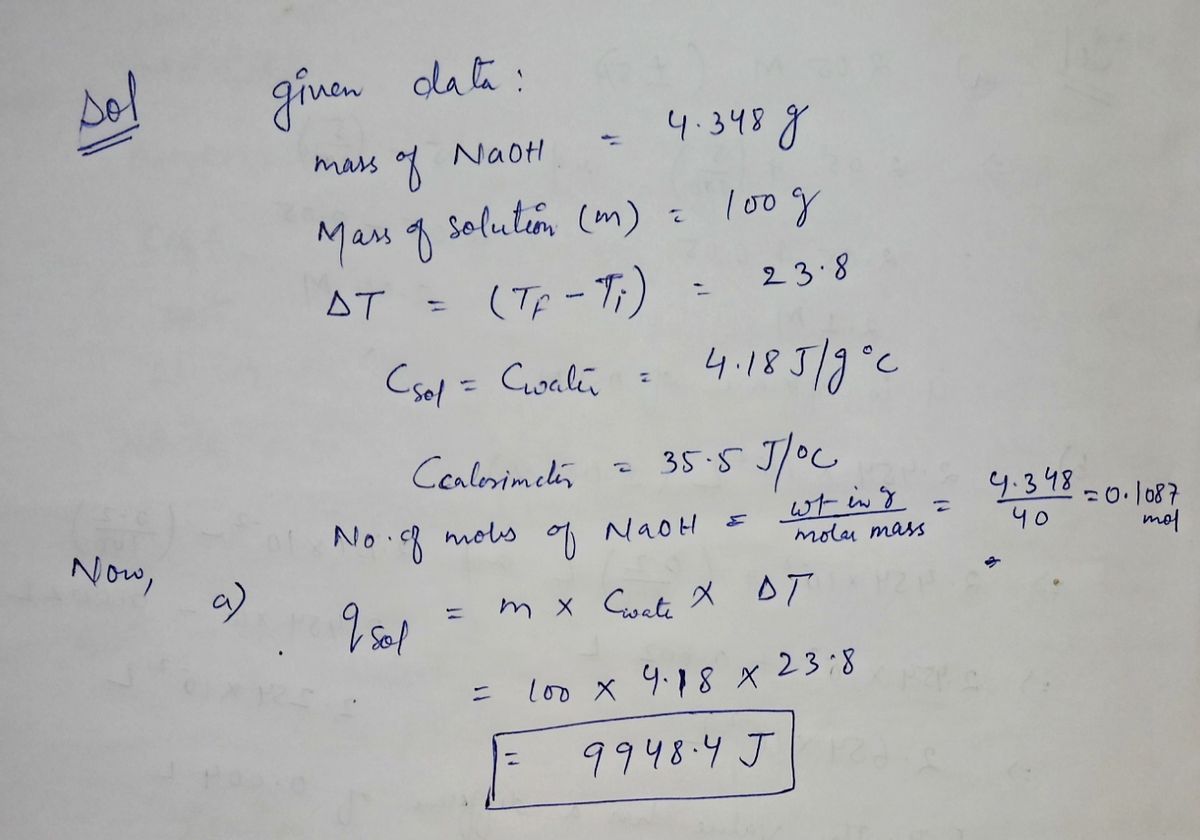2. A 4.348 g sample of NaOH(s) is dissolved in 100. g of water in a calorimeter, the temperature rises from 23.6 °C to 47.4 °C. Calculate AHdiss in kJ/mol. Assume that Ccalorimeter = 35.5 J/°C. Remember, for dilute solutions, C3oln = Cwater= 4.18 J/g•°C. %3D а. Calculate the amount of heat absorbed by the solution (qsoln). b. Calculate the amount of heat absorbed by the calorimeter (qcal). Determine the amount of heat given off as the 4.348 g NaOH dissolved (qdiss). Look at equation 2. Make sure to include an appropriate sign indicating whether it is an endothermic (+) or exothermic (-) process. с.
2. A 4.348 g sample of NaOH(s) is dissolved in 100. g of water in a calorimeter, the temperature rises from 23.6 °C to 47.4 °C. Calculate AHdiss in kJ/mol. Assume that Ccalorimeter = 35.5 J/°C. Remember, for dilute solutions, C3oln = Cwater= 4.18 J/g•°C. %3D а. Calculate the amount of heat absorbed by the solution (qsoln). b. Calculate the amount of heat absorbed by the calorimeter (qcal). Determine the amount of heat given off as the 4.348 g NaOH dissolved (qdiss). Look at equation 2. Make sure to include an appropriate sign indicating whether it is an endothermic (+) or exothermic (-) process. с.
Chemistry
10th Edition
ISBN:9781305957404
Author:Steven S. Zumdahl, Susan A. Zumdahl, Donald J. DeCoste
Publisher:Steven S. Zumdahl, Susan A. Zumdahl, Donald J. DeCoste
Chapter1: Chemical Foundations
Section: Chapter Questions
Problem 1RQ: Define and explain the differences between the following terms. a. law and theory b. theory and...
Related questions
Concept explainers
Question
Thanks so much!

Transcribed Image Text:2. A 4.348 g sample of NaOH(s) is dissolved in 100. g of water in a calorimeter, the temperature rises from
23.6 °C to 47.4 °C. Calculate AHdiss in kJ/mol.
Assume that Cealorimeter = 35.5 J'C. Remember, for dilute solutions, Csoln Cwater= 4.18 J/g-°C.
а.
Calculate the amount of heat absorbed by the solution (qsoln).
b. Calculate the amount of heat absorbed by the calorimeter (qcal).
Determine the amount of heat given off as the 4.348 g NaOH dissolved (qdiss).
Look at equation 2. Make sure to include an appropriate sign indicating whether it is an endothermic
(+) or exothermic (-) process.
с.
Expert Solution
Step 1
In this question we have to calculate the heat of Reaction by the given data of the calorimeter.

Trending now
This is a popular solution!
Step by step
Solved in 2 steps with 2 images

Knowledge Booster
Learn more about
Need a deep-dive on the concept behind this application? Look no further. Learn more about this topic, chemistry and related others by exploring similar questions and additional content below.Recommended textbooks for you

Chemistry
Chemistry
ISBN:
9781305957404
Author:
Steven S. Zumdahl, Susan A. Zumdahl, Donald J. DeCoste
Publisher:
Cengage Learning

Chemistry
Chemistry
ISBN:
9781259911156
Author:
Raymond Chang Dr., Jason Overby Professor
Publisher:
McGraw-Hill Education

Principles of Instrumental Analysis
Chemistry
ISBN:
9781305577213
Author:
Douglas A. Skoog, F. James Holler, Stanley R. Crouch
Publisher:
Cengage Learning

Chemistry
Chemistry
ISBN:
9781305957404
Author:
Steven S. Zumdahl, Susan A. Zumdahl, Donald J. DeCoste
Publisher:
Cengage Learning

Chemistry
Chemistry
ISBN:
9781259911156
Author:
Raymond Chang Dr., Jason Overby Professor
Publisher:
McGraw-Hill Education

Principles of Instrumental Analysis
Chemistry
ISBN:
9781305577213
Author:
Douglas A. Skoog, F. James Holler, Stanley R. Crouch
Publisher:
Cengage Learning

Organic Chemistry
Chemistry
ISBN:
9780078021558
Author:
Janice Gorzynski Smith Dr.
Publisher:
McGraw-Hill Education

Chemistry: Principles and Reactions
Chemistry
ISBN:
9781305079373
Author:
William L. Masterton, Cecile N. Hurley
Publisher:
Cengage Learning

Elementary Principles of Chemical Processes, Bind…
Chemistry
ISBN:
9781118431221
Author:
Richard M. Felder, Ronald W. Rousseau, Lisa G. Bullard
Publisher:
WILEY